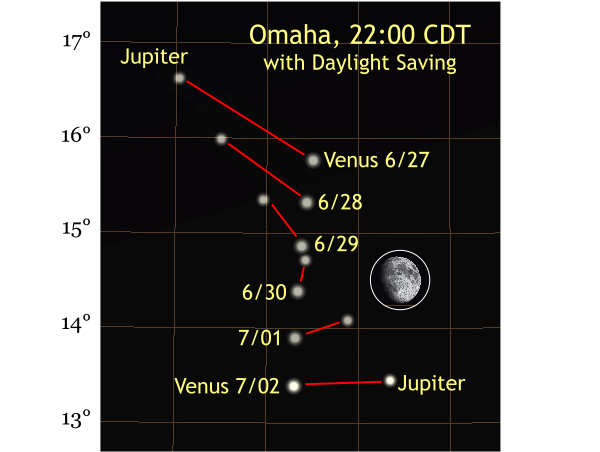We have already had a view from the Mediterranean of Jupiter, Venus and the Moon in Seeing Jupiter In Daylight. Jupiter and Venus are getting closer together in the sky, and on the 1st of July, at around 8:00 UTC, actual conjunction will occur, when the two planets are at the same Ecliptic longitude (referring the annual path taken by the Sun against our stellar background.) At that time, the planets will be below the Horizon for New World observers.
However, I did go back to Stellarium and prepared this map for readers in the USA, since I guess that that’s where the majority of our readers are. I chose Omaha, since it is pretty much central in the country, and prepared a map of the same part of the sky over six days at 3:00 UTC, since that’s when they will be at best visibility there, and plotted the track of the planets from 28th June to 3rd July all at that same time, that however is after sunset at 22:00 Central Daylight Time with Daylight Saving from 27th June to 2nd July, since it’s before midnight there.
Then I noticed something bizarre. On the 30th of June, the planets were closer than I expected, about one-third of a degree apart, compare the moon for size. I looked closely at the tracks of the planets. Jupiter appears to be taking a dive towards the Sun, but that’s because the far out giant appears relatively stationary against the stellar background, while the Sun is advancing by about a degree a day.
Venus is at present closing up more on the Sun, but while Jupiter is at present at about 1° Ecliptic North, Venus is only about 0.6° EN and is getting closer to the Ecliptic. So while the conjunction is around 8:00 UTC, closest approach is around 3:30 UTC. They will still be about 8° above the horizon sunset in Omaha: it will better be observed further east, good views should also be obtainable in Austin TX, Acapulco, Phoenix AZ and, Winnipeg, though the sky will be not so dark in the last two cities.
for a view from Britain see THIS PICTURE
Apologies if I’m an hour out in any of my calculations! Daylight saving can be a headache for astronomers.
Front Page Image: Jupiter, Venus and ecliptic from Reading, PA, after sunset at 22:00 Eastern Daylight Time with Daylight Saving on 30th June.




Comments